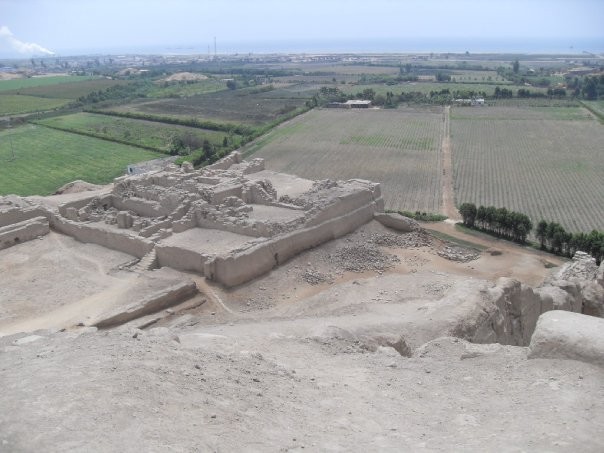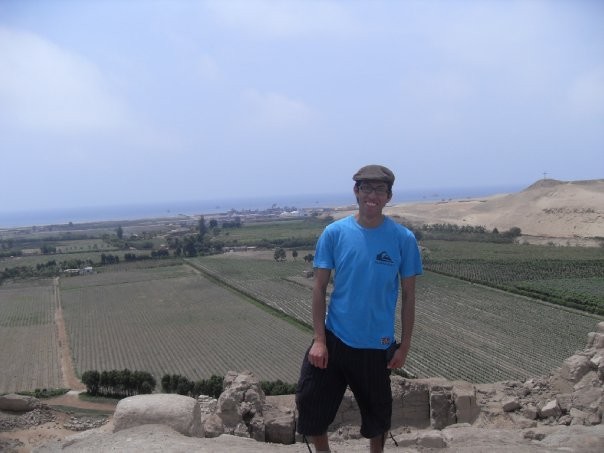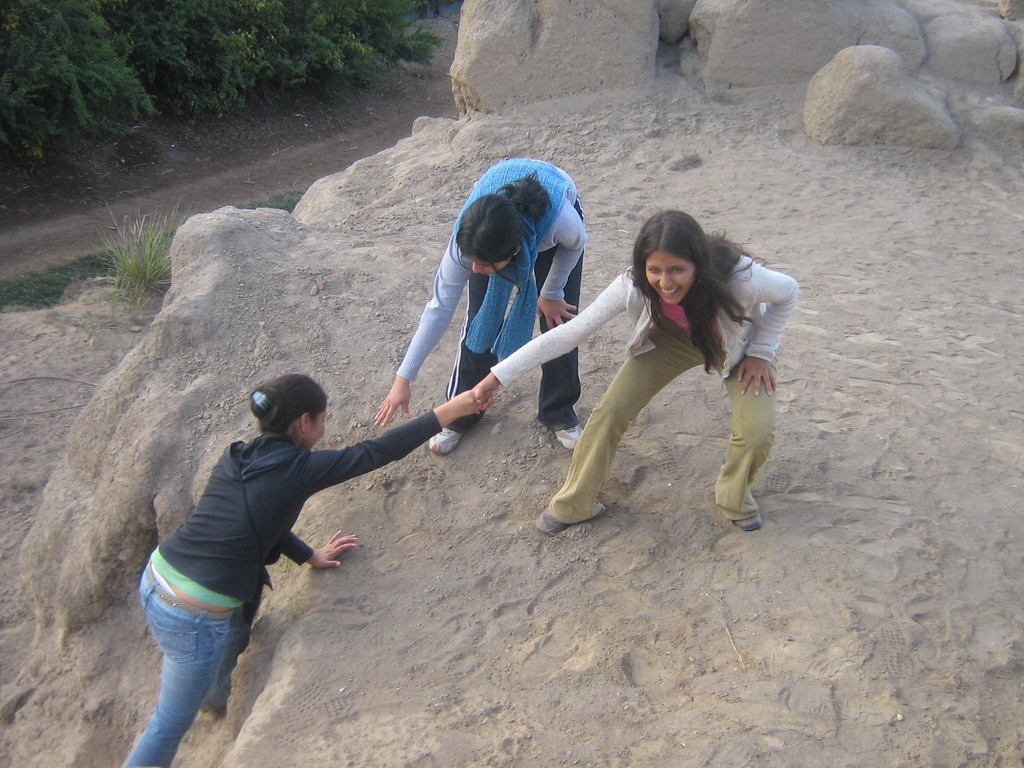Get to know the Huaca Centinela from the Chincha culture, with me
Hey everyone! I hope that you are all well. Today I want to tell you about a place that I remember from I was a little boy. Its name is Huaca Centinela and it is in Chincha, where my mother was born.
When I was a little boy, my grandmother took me to this archaeological centre on her motorbike to see my great-grandparents, who were still alive at the time. The Huaca Centinela is a Hispanic centre that belongs to the Chincha culture. It is located on the coasts of the Pacific ocean, on the side of the Tambo de Mora district which is known as the "port that makes you fall in love", three hours from Lima by bus.
Here is a picture of the Centinela centre with the sea in the background and the town on the left. The view is incredible. What you can see from the lower part on the left is the remains of the Inca presence throughout the Huaca. Since the Chinchas were subdued by the Incas without any war, they coexisted peacefully.

A special detail that I can tell you is that at the moment, this is the only archaeological museum in Chincha which is the "birthplace of the Afro-peruvian culture". Many black slaves settled on these fertile lands and little by little, made the city as we know it today and its other districts.
My mother was born in Sunampe which is the district that is most known for its Chincha wine. However, there are several Huacas throughout Chincha. Some are small and the larger ones are located in the town of Tambo de Mora. Also, very close to the Centinela, there is what would be part of a a graveyard belonging to this culture and from the top of it you can see the funeral remains that belonged to this old culture of Peruvian navigators.
Also, dear readers, I will tell you that the archaeological centre is located close to the sea in the Ica Department and thanks to them, the Chinchas were fishermen and came from many places. Until what we know today as Ecuador! This is due to the fact that you could find materials, that were very valuable to the Chinchas such as the mollusc, 'spondyllus' or spiny oysters. I want to tell you that this is a clear example of how in ancient Peru, the cultures had another vision of giving value to the things because of their beauty and relationship with nature. For example, gold was part of the ceremonial rites but did not have the economic value that it has today. This comes from the mercantilist influences which came from Spain, when Peru became one of the most prosperous colonies in the continent of South America.
Without doubt, I have a lot of love for the Huaca Centinela because this amazing place, has been present through my childhood and I have seen developing little by little, throughout the years. Of course, there is still a lot to do but today there is a museum and a guide for a symbolic value.
When I was a child the archaeological centre didn't have a museum. It didn't have a fence either and people could go in without any inconvenience. This really brought a lot of problems to the site because somehow it became a point for the 'huaqueras', who are people that go in to different archaeological sites in search of treasure or a special piece to traffic them. However, through time, the Huaca Centinela got a fence and then its museum, where they now exhibit the pieces of this impressive culture.

When you go into the museum you will find a lot of ceramics and some representations of ships, since as I mentioned initially, the inhabitants of the Chincha culture, were great merchants and navigators at sea.
Peru is a place that is home to different ancient cultures within its territory, some one after another and some at the same time. Saying that, I wanted to tell you that some foreign people think that you can only find the Inca culture in Peru. However this is not the case, the Chincha culture is a clear example of a thriving culture that existed in what was known as the late intermediate period. To give you a year, I would say the Chincha culture was approximately between 1000 and 1476, where their presence had flourished in more than one place. However the place that was most significant for the Chincha culture was the Huaca Centinela, a place with an enormous tourist potential which is almost 4000 m2. Over the years, many parts have been lost, such as the agricultural lands around Huaca Centinela.
On the other hand, I will tell you that the Gods of the Chincha culture, were called Chinchaycamac and Jaguar. This archaeological centre was the administrative centre of the culture.
The tour of the Huaca takes around 40 minutes and from the top of it you can see the sea, the cotton fields and the town of Tambo de Mora which in 2007, like the south of Peru, had a terrible earthquake which killed a lot of people and caused so much damage. In spite of that, people are moving forward and today the population of Tambo de Mora are looking for solutions to their problems through agriculture and fishing.
Here is a photo that I want to share with you which I took in Huaca Centinela and to the right, you can see a mountain with a small cross. However, it is not mountain but part of the culture of this area which was thriving in its time. From here, I could also walk to the beaches in Chincha such as 'playa el Socorro' which is about 25 minutes, to the right. I will also tell you that on this journey, you can come across some small lagoons where people will be selling delicious fruit lollipops. There are also some flour and fish factories and the remains of a Chincha jail, that fell because of the 2007 earthquake.

The Huaca Centinela has different period since this area also had the presence of the Inca culture. This is why, there were four of them, divided into territories during the Inca period. 'Chinchaysuyo' was one of them in honour of this town and in honour of the Chief of this culture. It is with this that we realise the importance of this archaeological centre. Like most of the pre-Hispanic centres that are on the coasts of Peru, they were built with adobe and even before the earthquake, it was common for the people who lived there to build their houses with adobe. Today, times are changing and and now people are replacing the adobe with brick.
I will tell you that something that caught my attention in the history and the chronicles that have been recovered, is that it is said that when the Spanish captured the Inca Atahualpa, they confused them with the Chief of Chinca (the governor of these lands), since they both wore very elegant clothing. It is through these chronicles, that you notice the magnitude and importance that this culture had for Peruvian civilization :) The people of that time had to explain to the Spanish, that this was the Lord of these lands and not the Inca they wanted to capture to be able to start a new period in the history of Peru.
This is one of the photos that I took when I was with my friends from university, doing an assignment about Chincha and its tourist spots. Here you can see the grape fields and some of its hills:

Unfortunately, before the museum came and the state tried to give it value, there were many informal excavations in order to look for valuable objects and thus destroy the heritage of Chincha. That is why it is said, that there were hidden treasures under the Huaca because there are legends about this archaeological centre. One of them is that, under its land, is the hidden treasure that the Chinchas hid before the Spanish came.
When you finish your tour, you can buy a special drink that is typical to the area called 'cachina de uva blanca', it's very similar to wine but much stronger. One time I was there and I was talking to the archaeologist from the museum and I got drunk from drinking the 'cachina'. It can be decieving because it is sweet but it is strong so don't get overconfident!
(in this photo, you can see my friends trying to climb the Huaca. We were doing a tourism assignment when we were students at San Marcos)

Where can you go to eat in the area?
Without a doubt, I would recommend the famous dish called sopa seca. It is a dish made with noodles, potatoes and stew with pieces of chicken. It has all the Afro-Peruvian flavor.
You can also go to the centre of Chincha and buy souvenirs like things made from bamboo and different sweets such as 'chocotejas' (Peruvican chocolate truffles), 'frejol colao' (Peruvian black bean pudding), etc.
I recommend that you visit this area in Peru and take the opportunity to get to know other places that are very close to Lima. An ideal time to go is around summer or whichever month suits you because the climate doesn't vary too much and you can almost always enjoy the sun.
How to get to the Huaca Centinela?
To get to the Huaca, you first need to go to the city of Chincha. If you are in Lima, you can take different buses from transport companies such as Ormeño, Soyuz, Jacksa and Señor de Luren, among many others that you will find in the Montevideo station in the centre of Lima. To be more specific it is at the back of the university park, near Abancay avenue. A ticket to Chincha can vary from 10 to 15 soles, depending on the company. It will also depend on the season and whether it is the weekend or not.
The buses go from Lima, 24hours a day and the journey takes approximately 2 and a half to 3 hours. From the square in Chincha, you can take the 'combis'(mini buses used for public transport in Peru) which go to Tambo de Mora and from there you can walk to the Huaca Centinela.
Another option that I took, since my grandmother lives in Sunample near the stadium, and the only thing she had to do was walk straight until she reached Socorro beach and then you just have to turn left and you will find the the archaeological centre.
Huaca Centinela's opening hours:
The general entrance to the Huaca is 7.50 soles for students. 2.00 soles for schools. 1.00 nuevo sol for elderly people. 3.00 nuevo soles. The times that you can visit are Monday to Sunday from 8:00 until 15:00.
Conclusion:
The archaeological centre of the Huaca Centinela was the administrative centre of the Chincha culture. It is located just a step away from the Tambo de Mora and there is a museum inside it where you can see things that were found there. If you go to Chincha and you want to get to know a place with a lot of history, you should come and have a guided tour of the Huaca Centinela.
In the near future, I would like to create a tourist project in this area since it is my mothers birthplace and I feel connected with this culture. Let's go to Chincha, family!
I hope that you have enjoyed this experience of one of my favourite places in Chincha. There will be another.
Photo gallery
Content available in other languages
Want to have your own Erasmus blog?
If you are experiencing living abroad, you're an avid traveller or want to promote the city where you live... create your own blog and share your adventures!
I want to create my Erasmus blog! →








Comments (0 comments)